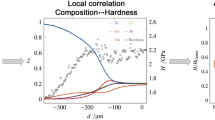Abstract
Based on detailed models of interatomic cohesion and the well-developed structural-thermodynamic approach, the interatomic bond energy has been determined for some covalent and metallic crystals and it has been found to agree with experimental data. Using the proposed analytical relationship for the degree of covalency of crystals the author has elaborated a generalized model that describes experimental hardness of supersclerometer materials (diamond, cBN, SiC, and others), minerals, refractory compounds, semiconductors, ionic crystals and metals. On the basis of the mechanical-chemical approach to (nano)flow a dislocation model of crystal-mechanical anisotropy of yield strength has been put forward for monocrystalline diamond and lonsdaleite; the model makes it possible to draw a conclusion on a slight difference in their sclerometric characteristics. The experimental relationships that govern high-temperature high-pressure plasticity in some covalent crystals are discussed.
Similar content being viewed by others
References
Novikov, N.V. (Ed.), Fizicheskie svoistva almaza: Spravochnik (Physical Properties of Diamond. Handbook), Kiev: Naukova Dumka, 1987.
Novikov, N.V. (Ed.), Sintez, spekanie i svoistva kubicheskogo nitrida bora (Synthesis, Sintering, and Properties of Cubic Boron Nitride), Kiev: Naukova Dumka, 1993.
Novikov, N.V. (Ed.), Sintez sverkhtverdykh materialov (Synthesis of Superhard Materials), Kiev: Naukova Dumka, 2002, vol.1.
Gao, F.M. and Gao, L.H., Microscopic models of hardness, J. Superhard Mater., 2010, vol. 32, no. 3, pp. 148–166.
Karapetyants, M.Kh. and Drakin, S.I., Stroenie veshchestva (Structure of Matter), Moscow: Vysshaya Shkola, 1978.
Samsonov, G.V. (Ed.), Fiziko-khimicheskie svoistva elementov. Spravochnik (Physicochemical Properties of Elements. Handbook), Kiev: Naukova Dumka, 1965.
Coulson, C., Valence, Oxford University Press, 1961.
Kikoin, I.K. (Ed.), Tablitsy fizicheskikh velichin. Spravochnik (Tables of Physical Quantities. Handbook), Moscow: Atomizdat, 1976.
Boron nitride, boron carbide, boron, silicon, germanium, beryllium oxide, gold, tin: https://en.wikipedia.org/wiki.
Frantsevich, I.N. (Ed.), Sverkhtverdye materialy (Superhard Materials), Kiev: Naukova Dumka, 1980.
Frantsevich, I.N. (Ed.), Uprugie postoannye i moduli uprugosti metallov i nemetallov. Sprav. (Elastic Constants and Elastic Moduli of Metals and Nonmetals), Kiev: Naukova Dumka, 1982.
Lysenko, A.V., Structural and mechano-chemical features of high-pressure phases forming at p, Tand p-treatment of graphite, J. Superhard Mater., 2014, vol. 36, no. 6, pp. 401–409.
Gilman, J., Mechanical properties of ionic crystals, Uspekhi Fiz. Nauk, 1963, vol. 80, no. 3, pp. 456–503.
Fedorov, D.K., Shorshorov, M.K., and Khakimova, D.K., Uglerod i ego vzaimodeistvie s metallami (Carbon and Its Interaction with Metals), Moscow: Metallurgiya, 1978.
Lysenko, A.V., Force constants of elastic deformation of chemical s-bonds in diamond and superhard single crystals having a sphalerite lattice, Sverkhtverdye Materialy, 2005, no. 3, pp. 46–56 [J. Superhard Mater., 2005, no. 3].
Ormont, B.F., On the incorrect use of the notion of the crystal lattice energy in relevant publications and on the advisability of introducing the notion of the atomization energy, Zhurn. Fiz. Khim., 1957, vol. 31, no. 2, pp. 509–510.
Shaskol’skaya, M.P., Kristallografiya (Crystallography), Moscow: Vysshaya Shkola, 1976.
Weiss, R., Solid-State Physics for Metallurgists, Pergamon Press, 1963.
Haberditzl, W., Basteine der Materie und Chemische Binding (Structure of Matter and Chemical Bond), Berlin: VEB Deutscher Verlag der Wissenscaften, 1972.
Kurilenko, O.D., Kratkiy spravochnik po khimii (Quick-Reference Handbook of Chemistry), Kiev: Naukova Dumka, 1965.
Mishchenko, K.P. and Ravdel’, A.A., Kratkiy spravochnik fiziko-khimicheskikh velichin (Quick-Reference Handbook of Physical-Chemical Quantities), Leningrad: Khimiya, 1967.
Hildenbrand, D.L. and Hall, W.F., The vaporization behavior of boron nitride and aluminium nitride, J. Phys. Chem., 1955, vol. 67, pp. 888–893.
Bernstein, H.J., Bond energies in hydrocarbons, Trans. Farad. Soc., 1962, vol. 58, no. 12, pp. 2285–2287.
Nikol’skii, B.P. (Ed.), Spravochnik khimika v dvukh tomakh (Chemist’s Handbook in Two Volumes), Leningrad: Khimiya, 1971, vol.1.
Yablonskii, G.S., Bykov, V.I., and Gorban’, A.N., Kineticheskie modeli kataliticheskikh reaktsii (Kinetic Models of Catalytic Reactions), Novosibirsk: Nauka, 1983.
Gilman, J.J., Flow of covalent solids at low temperatures, J. Appl. Phys., 1975, vol. 46, no. 12, pp. 5110–5113.
Tkachenko, Yu.V., The Influence of High Hydrostatic Pressure on Microhardness of Ionic and Covalent Crystals. Extended Abstract of Cand. Sci. (Phys.-Chem.), Donetsk, 1994.
Shul’zhenko, A.A., Determination of ultimate compression strength of synthetic diamonds, Sinteticheskie Almazy, 1969, issue 6, pp. 27–36.
Marsh, D.M., Plastic flow in glass, Proc. Roy. Soc. A, 1964, vol. 279, no. 1378, pp. 420–435.
Bokiy, G.B., Bezrukov, G.N., and Naletov, A.M., Prirodnye i sinteticheskie almazy (Natural and Synthetic Diamonds), Moscow: Nauka, 1986.
Barenblatt, G.I. (Ed.), Mekhanicheskie svoistva novykh materialov (Mechanical Properties of New Materials), Moscow: Mir, 1966.
Author information
Authors and Affiliations
Corresponding author
Additional information
Original Russian Text © A.V. Lysenko, 2017, published in Sverkhtverdye Materialy, 2017, Vol. 39, No. 1, pp. 35–46.
About this article
Cite this article
Lysenko, A.V. Interatomic bond energy and analytical scale of hardness. J. Superhard Mater. 39, 25–33 (2017). https://doi.org/10.3103/S1063457617010038
Received:
Published:
Issue Date:
DOI: https://doi.org/10.3103/S1063457617010038




